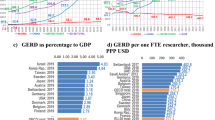Abstract
Brazilian science has increased fast during the last decades. An example is the increasing in the country’s share in the world’s scientific publication within the main international databases. But what is the actual weight of international publications to the whole Brazilian productivity? In order to respond this question, we have elaborated a new indicator, the International Publication Ratio (IPR). The data source was Lattes Database, a database organized by one of the main Brazilian S&T funding agency, which encompasses publication data from 1997 to 2004 of about 51,000 Brazilian researchers. Influences of distinct parameters, such as sectors, fields, career age and gender, are analyzed. We hope the data presented may help S&T managers and other S&T interests to better understand the complexity under the concept scientific productivity, especially in peripheral countries in science, such as Brazil.





Similar content being viewed by others
Notes
Examples: BBC/Brasil (2010) Produção científica do Brasil ultrapassa a da Rússia, indice levantamento. Available at: http://www.bbc.co.uk/portuguese/ciencia/2010/01/100127_brasil_russia_ciencia_rw.shtml; Folha de São Paulo (2009) Produção científica cresce 56% no Brasil. Available at: http://www1.folha.uol.com.br/folha/ciencia/ult306u561181.shtml; KING C. (2009) Brazilian Science on the Rise. ScienceWatch. Available at: http://sciencewatch.com/ana/fea/09julaugFea/.
CNPq is the short name for National Council for Scientific and Technological Development.
References
Allison, P. D., & Stewart, J. A. (1974). Productivity differences among scientists: evidence for accumulative advantage. American Sociological Review, 39, 596–606.
Basu, A. (2010). Does a country’s scientific ‘productivity’ depend critically on the number of country journals indexed? Scientometrics, 82, 507–516.
Batista, P. D., Campiteli, M. G., Kinouchi, O., & Martinez, A. S. (2006). Is it possible to compare researchers with different scientific interests? Scientometrics, 68, 179–189.
BritoCruz, C. H. (2007). Ciência e tecnologia no Brasil. Revista USP, 73, 58–90.
Cohen, J. E. (1991). Size, age and productivity of scientific and technical research groups. Scientometrics, 20, 395–416.
Costas, I. (2002). Women in science in Germany. Science in Context, 15, 557–576.
Etzkowitz, H., & Leydesdorff, L. (2000). The dynamics of innovation: from national systems and “mode 2” to a triple helix of university-industry-government relations. Research Policy, 29, 109–123.
Fox, M. F. (1983). Publication productivity among scientists: a critical review. Social Studies of Science, 13, 285–305.
Glanzel, W., & Moed, H. (2002). Journal impact measures in bibliometric research. Scientometrics, 53, 171–193.
Glanzel, W., Leta, J., & Thijs, B. (2006). Science in Brazil. Part 1: a macro-level comparative study. Scientometrics, 67, 67–86.
Guimaraes, J. A., & Humann, M. C. (1995). Training of human-resources in science and technology in Brazil. The importance of a vigorous postgraduate program and its impact on the development of the country. Scientometrics, 34, 101–119.
Hirsch, J. E. (2005). An index to quantify an individual’s scientific research output. PNAS, 102(46), 16569–16572.
Hu, X., Rousseau, R., & Chen, J. (2010). In those fields where multiple authorship is the rule, the h-index should be supplemented by role-based h-indices. Journal of Information Science, 36, 73–85.
King, C. (2009). Brazilian science on the rise. ScienceWatch. Available at: http://sciencewatch.com/ana/fea/09julaugFea/.
Lane, J. (2010). Let’s make science metrics more scientific. Nature (Opinion), 464, 488–489.
Leite, P., Mugnaini, R., & Leta, J. (2009). International versus national publications: the case of Brazilian scientists. Proceedings ISSI 2009, 2, 962–963.
Leta, J., Glänzel, W., & Thijs, B. (2006). Science in Brazil. Part 2: sectoral and institutional research profiles. Scientometrics, 67, 87–105.
Morel, R. L. M., & Morei, C. M. (1977). Um estudo sobre a produção científica brasileira, segundo os dados do Institute for Scientific Information (ISI). Ciência da Informação, 6, 99–109.
Pinheiro-Machado, R., & Oliveira, P. L. (2001). The Brazilian investment in science and technology. Brazilian Journal of Medical and Biological Research, 34, 1521–1530.
Regalado, A. (2010). Brazilian science: riding a gusher. Science, 330, 1306–1312.
Schiebinger, L. (2002). European women in science. Science in Context, 15, 473–481.
Sikka, P. (1997). Statistical profile of science and technology in India and Brazil. Scientometrics, 39, 185–195.
UNESCO. (2001). The state of science and technology in the world. http://www.uis.unesco.org/file_download.php?URL_ID=4980&filename=10289086730WS_report_2001.pdf&filetype=application/pdf&filesize=695528&name=WS_report_2001.pdf&location=user-S/. Accessed 26 October 2009.
Vasconcelos, S. M. R., Batista, P. D., Sant’ana, M. C., Sorenson, M. M., & Leta, J. (2008). Researchers writing competence: A bottleneck in the publication of Latin American science? EMBO Reports, 9, 700–702.
Wallner, B., Fieder, M., & Iber, K. (2003). Age profile, personnel costs and scientific productivity at the University of Vienna. Scientometrics, 58, 143–153.
Acknowledgment
We thank CNPq, especially the support of Silvana M. Cosac, for the database set up for this study and for the PhD fellowship awarded to Paula Leite. This study was supported by CNPq - Process number 483095/2009 - 5.
Author information
Authors and Affiliations
Corresponding author
Rights and permissions
About this article
Cite this article
Leite, P., Mugnaini, R. & Leta, J. A new indicator for international visibility: exploring Brazilian scientific community. Scientometrics 88, 311–319 (2011). https://doi.org/10.1007/s11192-011-0379-9
Received:
Published:
Issue Date:
DOI: https://doi.org/10.1007/s11192-011-0379-9




